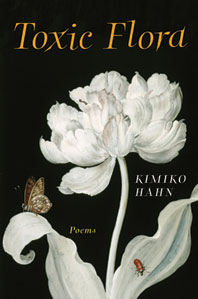 (This interview was first published in the July 2010 issue of The Practicing Writer.)
(This interview was first published in the July 2010 issue of The Practicing Writer.)
AN INTERVIEW WITH POET AND PROFESSOR KIMIKO HAHN
by Erika Dreifus
One of the best aspects of my job at The City University of New York is the opportunity it has afforded me to become acquainted with some exceptionally talented writers-who-teach. Kimiko Hahn is among these stars.
Hahn is the author of eight books of poems, including: Earshot (Hanging Loose Press, 1992), which was awarded the Theodore Roethke Memorial Poetry Prize and an Association of Asian American Studies Literature Award; The Unbearable Heart (Kaya, 1996), which received an American Book Award; The Narrow Road to the Interior (W.W. Norton, 2006), which takes its title from Basho’s famous poetic journal; and Toxic Flora, poems inspired by science (W.W. Norton, 2010). Hahn has also written text for film, such as the 1995 two-hour MTV special, Ain’t Nuthin’ But a She-Thing (for which she also recorded the voice-overs); also, the text for Everywhere at Once, Holly Fisher’s film based on Peter Lindbergh’s still photos and narrated by Jeanne Moreau.
Hahn is a recipient of a Guggenheim Fellowship, PEN/Voelcker Award, Shelley Memorial Prize and Lila Wallace-Reader’s Digest Writers’ Award as well as fellowships from the National Endowment for the Arts and the New York Foundation for the Arts. She is a distinguished professor in the MFA Program in Creative Writing and Literary Translation at Queens College, The City University of New York.
Please welcome Kimiko Hahn.
ERIKA DREIFUS (ED): This collection is inspired by articles from the weekly “Science Times” section of The New York Times. When did you begin writing poems inspired by the Science Times, and how did you realize that a collection was developing on this theme?
KIMIKO HAHN (KH): I frequently use outside sources for my poems. Scientific language in particular is so exotic to my ear and the world of science so intriguing, that I often find myself drawn to that realm. The “Science Times” is particularly wonderful because the writers present such clear explanations and the writing itself is first rate. I was working on a sequence using the Science Times and at one point realized that I had begun to accumulate a lot of sections. My husband suggested a whole book and I began to reorganize. That was over seven years ago. Anything that wasn’t related (like poems “talking back” to canonical works or random pieces) is now on a separate doc somewhere on my computer.
ED: Your new book can certainly earn you a reputation as a “nature writer.” You live and teach in New York City; I’m inspired to ask you to respond to Galway Kinnell’s notion – which, frankly, I have only recently learned about – that the modern nature poem must include the city.
KH: I just Googled what might be the quote you refer to and a part of it is: “I don’t recognize the distinction between nature poetry and, what would be the other thing? Human civilization poetry? We are creatures of the earth who build our elaborate cities and beavers are creatures of the earth that build their elaborate lodges and canal operations and dams, just as we do. The human is unique in that it’s taken over, but that’s no reason to say that the human is of a different kind, a kind created in the image of some god while all the others are created in the image of mere lumps of dirt.” I suppose as humans we need to categorize as well–nature poetry, political, love, etc. This is useful, but they are finally all of a piece. For Toxic Flora, the fascinating scientific material triggered my own responses. I was interested in juxtaposing rather than lineating the “information” in the manner of a found poem….But must we include the city? The word “must” is a problem.
ED: What kind of response has the book evoked so far from the writers at “Science Times” and/or the NYT?
KH: Last summer I met quite by chance David Corcoran who is a science editor at the NYT. He interviewed me for a July TierneyLab post. A few weeks ago, he initiated an invitation to their staff meeting–that was frightening and exhilarating.
ED: You teach a class on poetic closure. Can you describe for us one of the closings you’re most proud of in the new collection?
KH: Well, a friend of mine is partial to “The Search for Names,” a poem about a girl who entered a contest to name a planet and won with “Pluto.” The last line is: “Lucky girl. Fortunate planet. Exultant netherworld.” I wanted to cover three elements brought up in this short poem and have adjectives that increasingly (1, 2, 3) broke open the nouns so that the final one would be: abstract, a reference to mythology, and how the shadow-side wins out even in this small narrative. I think that’s what I was doing. I’m not big on poets interpreting their own work….
ED: What are you currently working on?
KH: I thought I was finished with science but it isn’t finished with me. Last fall I had my first sabbatical in sixteen years and I began playing around with more “Science Times” clippings. I also picked up a 1910 handbook in a dollar-bin and this immediately triggered a series of prose poems. I’m not sure what I’ll do this summer–that is, which will be the exultant sequence. Or if something else will become more urgent.
ED: Thank you for your time, Kimiko.
For other interviews with and profiles of Kimiko Hahn focusing on her new book, and sample poems, please see the following: